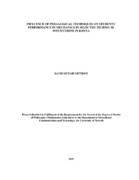| dc.description.abstract | Mechanics plays an important role in developing students’ capacity to experiment, analyze, synthesize and evaluate situations in and out of college. It is a catalyst for developing students’ cognitive and interpersonal abilities such as analytical, creative, critical and logical reasoning as well as problem solving. Despite the significant role played by mechanics in students’ abilities, poor performance is global problem. The purpose of this study was to explore the influence of pedagogical techniques on students’ performance in Mechanics in selected diploma technical institutions in Kenya. The specific objectives of this study were: to compare students’ performance in mechanics when students are taught using steeplechase activities and when students are taught using traditional methods; to compare students’ performance in mechanics when students are taught using steeplechase activities and when students are taught using lecturer’s demonstration; to establish the influence of using steeplechase activities for teaching on students’ performance in mechanics for different ability groups; and to find out the influence of using steeplechase activities on students’ performance in mechanics for gender groups. The study aimed at contributing to knowledge on modeling mechanics problems. Causal comparative research design was used for this study on influence of using steeplechase activities for teaching on students’ gains (as predictor of performance) in mechanics. Sixteen (16) colleges were randomly selected to participate in the study based on geographical location and type of group targeted. Simple stratified random sampling was used to pick student and steeplechaser respondents. Purposive sampling was used to pick the chosen first year 96 (= 75; = 21) lecturers. Sixteen (16) colleges had 768 first year students from which a sample of 384 students was randomly selected. The study worked with 120 steeplechasers from which a random sample of 60 was selected. Data was collected by use of questionnaires for mechanics lecturers, pre-test, post-test; and steeplechasers’ interview schedule. Categorical data was presented in distribution tables and graphs showing frequencies and percentages.
Quantitative data was presented in tables showing arithmetic means, standard deviations, ordinary gains and normalized gains. Quantitative data was analyzed using t-statistic as used in Statistical Package for Social Sciences (SPSS) to establish whether there was a significant difference between the means of the groups being compared in hypotheses testing. The study found that traditional method of teaching such as: lecture method, questioning, dictation of notes and lecturer’s demonstration were the most predominant (85%) in mechanics lessons. Test of hypothesis suggested that when students were taught using steeplechase activities, their performance in mechanics could be improved compared to alternative methods of teaching. The normalized gain made by experimental group was 47% (. . = 12.376) compared to traditional methods of teaching (15%;. . = 10.480) and lecturer’s demonstration (22%;. . = 9.383). The results in the test of hypotheses also suggested that the high ability group benefitted more from using steeplechase activities for teaching than the low ability group. The results on test of hypothesis also suggested that using steeplechase activities for teaching had the capacity to reduce gender difference in students’ performance in mechanics.
The study also found that teaching students using steeplechase activities could develop their mathematics skills. The study found that when steeplechase activities were used for teaching, they might have the capacity to make learning of mechanics more meaningful and captivating.
The research findings lead to the conclusion that steeplechase activities have the capacity to improve students’ performance in mechanics. The study recommended the use of steeplechase activities as pedagogical techniques for improving students’ performance in mechanics. The study recommends the replication of this study to other branches of mathematics and other science based disciplines. | en_US |
